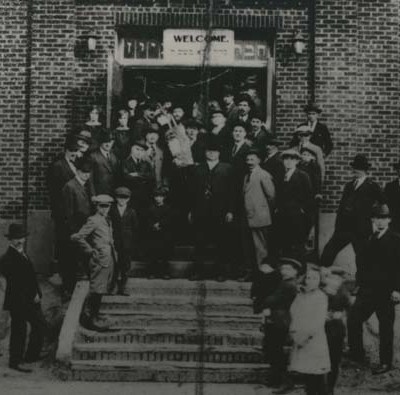
While the city of Sharon was already sizable by 1900, construction of a Sharon Steel Corporation mill on farmland south of the city in 1901 brought an additional influx of people to the southwestern corner of Mercer County. The borough of South Sharon was incorporated in 1916. The name of the city was later changed to Farrell, in honor of U.S. Steel Company President James Farrell.
Among the earliest settlers to Farrell was a group of Hungarian Jews, including the family of Jacob and Rosa Gross. Even though nearby Sharon already had an establish congregation at the time, the group in Farrell formed an Orthodox congregation called B’nai Zion in 1902. They worshipped at a wood-frame building on Greenfield Avenue (now Market Avenue) until 1917 or 1918, when they built a brick synagogue at Spearman Avenue and Union Street. The congregation bought a neighboring building in 1919 for living quarters. The early records had gone missing by 1939 and later records also subsequently went missing or were destroyed.
On August 21, 1903, B’nai Zion acquired approximately 6.5 acres of land in Hickory Township for a cemetery. The cemetery later merged with Ahavath Achim in Farrell and later with Beth Israel in Sharon. In 1905, B’nai Zion organized a Hebrew Ladies Aid Society. In 1908, a group of Russian and Rumanian immigrants started Ahavas Achim Congregation “to worship in their own way,” according to the WPA Church Archives. The Orthodox congregation was located at 929 Lee Avenue. A Rabbi Cohen led the congregation from its inception until 1910. Between 1928 and 1930, according to various sources, many of the members had either died or moved away and so the remaining congregation paid its outstanding bills, destroyed its records and merged with B’nai Zion.
In 1926 or 1927, a small group of members of B’nai Zion and Ahavas Achim “decided to try an experiment of their own for new ideas or to set an example,” according to the WPA Church Archives. The members of this group started a new congregation while retaining their official membership in the two existing congregations. The project was seen as “radical” by some of the older members of the community. The “experiment” only lasted a few years, before the members of the breakaway group rejoined the other congregations.
By the time the population of Farrell peaked in the 1920s, the town was home to approximately 500 Jews and Mercer County was home to more than 1,000 Jews, according to the American Jewish Yearbook. The Jewish community in Farrell had a chapter of Hadassah and jointly managed a section of the National Council of Jewish Women with women from neighboring Sharon, as well as running other communal organizations independently and jointly. The community in Farrell also operated a mikveh (ritual bath) and employed a shochet (kosher slaughterer) well into the 1940s.
By World War II, Mercer County had two congregations: the traditional B’nai Zion in Farrell and the liberal Temple Beth Israel in Sharon. The congregations combined their religious schools in 1967 and merged entirely in 1972. For many years after the merger, the members of Congregation B’nai Zion continued to hold a separate traditional service in the Temple Beth Israel social hall on certain occasions, particularly the High Holidays.
Although membership remained stable for years, the merged congregation struggled to attract new members, particularly after the closure of the Westinghouse plant in Sharon in 1985 and the Sharon Steel Corporation plant in 1992. With no signs of growth evident, Temple Beth Israel merged with Congregation Rodef Sholom of Youngstown in 2013.
This exhibit was made possible through the generous support of the Youngstown Area Jewish Federation.